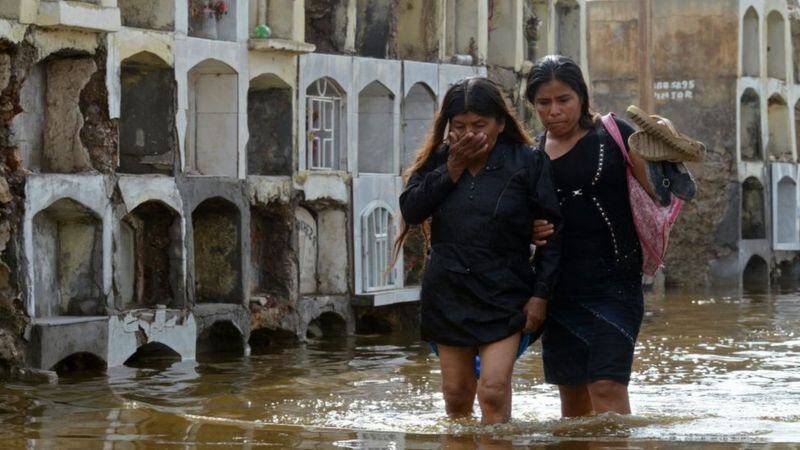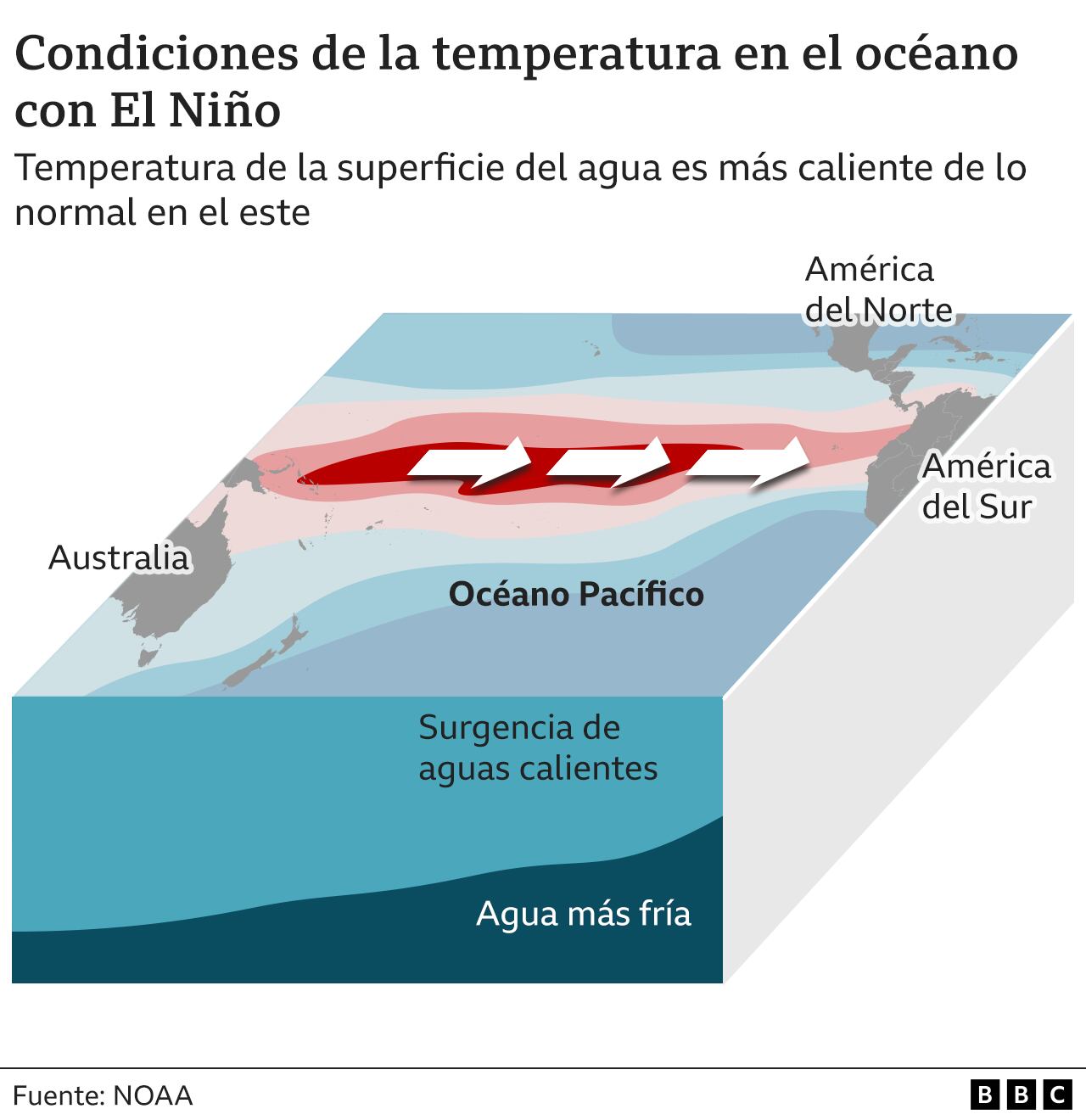The last time it was formed The boy It was in 2016 and its effects were felt all over the world.
This weather phenomenon contributed to the record rise in global temperatures, the loss of tropical forests, coral bleaching, the generation of forest fires and polar melting.
LOOK: A powerful El Niño phenomenon is forming: The “inexplicable” warming of the oceans that alarms scientists
Now scientists believe that it will happen again and that is why they are warning about the possibility of a powerful El Niño forming in the coming months in a context in which, in addition, there is a “sudden and unexpected” warming of the oceans, which which together could lead to record global temperatures between 2023 and 2024.
But what do we know about this phenomenon and why is it worrying?
extreme events
El Niño is a natural weather phenomenon -not caused by man- of which there are references, at least, since the end of the 19th century.
“El Niño is basically a change in the strength and direction of the trade winds that blow from east to west in the Pacific Ocean.which causes the warm water found in the western part of the Pacific Ocean to move towards the central and eastern Pacific region,” explains Ángel Adames Corraliza, professor of Atmospheric Sciences at the University of Wisconsin, to BBC Mundo.
It is not an innocuous change.
Adames, the expert points out that the movement of these warm waters favors a significant increase in ocean temperatures in the central and eastern Pacific.
“High ocean temperatures are more conducive to heavy downpours and floods. And that has consequences for the hydrological cycle on the west coast of South America, especially in Peru and Ecuador. There are even direct effects on atmospheric circulation that cause changes in the weather conditions and in the climate in general both in North and South America and in other parts of the world as well,” he says.
Adames assures that this causes concern, especially because a strong El Niño – like the one being forecast for this year – is often associated with extreme weather events.
“We are talking about the possibility of seeing extreme weather events that do not tend to occur commonly, because El Niño basically changes the climate. So we see things that are not usual in different regions. That is a reason to worry,” he says.
This meteorological phenomenon causes, for example, that in regions that are usually very rainy, such as the north of Australia, droughts and fires occur; while in places like the west coast of South America, whose climate is dry and which is known for its deserts, heavy rains occur.
“The first impact that is seen is the warming off the coast of Peru. This year, if the record is not broken, it is almost done. It is extremely hot and we have seen downpours with an intensity and strength that are not commonly seen, except when you have these very high temperatures, causing tremendous floods, landslides and loss of life and material resources“Adams says.
The expert explains that the development of El Niño, especially if ocean temperatures continue to rise, usually leads to a more active hurricane season in the eastern and central Pacific.
“During El Niño years there is an increased risk of hurricanes for the west coast of Mexico and for Hawaii. We frequently see hurricanes or typhoons that cross the ocean and more intense hurricanes occur in the southernmost region of the western Pacific Ocean. In contrast, hurricane activity in the Atlantic Ocean decreases,” he notes.
Adames indicates that, although it is still something that is being studied, there are indications that El Niño tends to cause drought in the Caribbean during the boreal summeraffecting places like Cuba, the Dominican Republic and Puerto Rico.

At times, this drought can spread to Central America -from Panama to Honduras, especially-, as well as cause heat waves in the Amazon region.
“In general, the impacts tend to be more of heat and drought for Latin America, but the largest effects tend to occur on the western slope of the Andes and the mountains that predominate in Latin America. So we’re talking about Lima and all the big cities in that coastal region on the Pacific side of South America that tend to get really big hits in terms of downpours and heat,” Adames says.
global warming reinforcement
Although El Niño has a natural origin unrelated to global warming caused by human activities, it can contribute to the increase in temperatures on the planet.

This weather phenomenon is characterized by a release of heat from the Pacific Ocean into the atmosphere, through which it is distributed.
“El Niño years tend to be warmer than normal, so if we have a possibly record-breaking El Niño this year, or it’s extremely strong, we’re talking about a significant warming of the atmosphere that will be adding to the global warming caused by humansAdames warns.
“The second half of this year – and more likely next year – will be an extremely hot period with a lot of heat waves because we’re talking about El Nino warming in addition to human-caused warming. So possibly 2024 or the end of this year, it will be one of the warmest we have experienced on record“, he added.
The United States Weather Service (NWS) issued an alert for El Niño, because there are early indications that it is likely to develop in the coming months.
According to the NWS, there is a 62% chance that this phenomenon will develop between May and July of this year. Also estimated the chances of a “strong” El Niño at 40%.
Ángel Adames affirms that April is a very difficult time to anticipate the appearance of this phenomenon, but he pointed out that there are several signs that suggest that it will happen.
First, it points to the high temperatures that have been recorded off the coast of Peru.
He explains that there are a series of buoys placed in the equatorial region of the Pacific to measure the ocean temperature not only on the surface, but also at depth, and at this time all of them are indicating a warming that would be registered from the coast of Peru to almost reaching the coast of New Guinea. “So we’re talking about major warming,” he notes.
A second indicator would be a change that occurred a few weeks ago in the direction of trade winds to westerlies. “Usually when the winds change direction, that speeds up the movement of warm water towards the eastern Pacific region and that is a pretty strong indication that El Niño is developing,” he says.
The last indicator is weather prediction models. “Right now, the vast majority of them are indicating that we are heading towards a strong El Niño,” he adds.
Source: Elcomercio
I am Jack Morton and I work in 24 News Recorder. I mostly cover world news and I have also authored 24 news recorder. I find this work highly interesting and it allows me to keep up with current events happening around the world.

:quality(75)/cloudfront-us-east-1.images.arcpublishing.com/elcomercio/3O2BKSHAKNBPDDBCCDWSHNQNCA.jpg)

:quality(75)/cloudfront-us-east-1.images.arcpublishing.com/elcomercio/JTX3TZCOI5EL7PSB23GTONH434.jpg)

:quality(75)/cloudfront-us-east-1.images.arcpublishing.com/elcomercio/QDFA5LW6LNHTZDOAPORQ2KKM3E.jpg)
:quality(75)/cloudfront-us-east-1.images.arcpublishing.com/elcomercio/QKTDZ7M56JA5HFSCVK3MFOSFGA.jpg)
